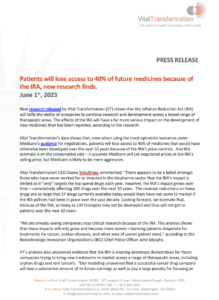The Executive Summary
-
Vital Transformation (VT) modeled and estimated the impacts of the Inflation Reduction Act’s (IRA) pricing provisions for a cohort of the top 200 Part B and D drugs by CMS spend, resulting in 92 drugs impacted by IRA in the next 10 years, which are produced, collectively, by 41 biopharmaceutical companies.
-
Had the IRA been in place beginning in 2014, we estimate the reductions in revenue on the impacted drugs to be up to 40%. Because of this, between 24 and 49 therapies currently available today would most likely not have come to market and therefore not available for patients and their providers.
-
Looking forward, we estimate that because of the IRA pricing provisions, the substantial reduction in revenue will significantly narrow investment opportunities. Conservatively, as many as 139 drugs over the next 10 years are at risk of not being developed at all.
-
Both biologics and small molecule drugs are impacted, with an average reduction in revenue per therapy of $4.9 billion and $4 billion respectively.
-
IRA provides a negotiation exemption for orphan drugs that treat only one rare disease. This disincentivizes investments in orphan drugs and areas of high unmet patient need as the broader indications will provide a superior return on investment, as much as $500 million over three years.
-
Based on two impact scenarios, we estimate a loss of between 66,800 – 135,900 direct and 342,000 – 676,000 indirect jobs in the U.S. biopharma ecosystem.
Conclusions and Implications of IRA
-
IRA reduces net earnings for a 41 company cohort, but these impacts are highly concentrated in only 10 firms.
-
As measured by EBIT (annual net earning):
-
The IRA induced revenue reductions exceed 350% of the annual earnings for 25% of the 41 companies in our cohort.
-
The IRA penalizes the most innovative, successful therapies which fund an outsized amount of research.
-
The IRA penalizes successful biopharma companies.
-
The IRA’s orphan drug carve-outs appear to have large unintended consequences for assets with limited ability to seek secondary indications – according to our modeling, any extra indication must produce at minimum 40% more revenue to offset the losses created by IRA.
-
IRA may act as a disincentive to the current strategy in oncology of launching with an orphan indication to de-risk R&D – this will require a major paradigm shift for the industry, negatively impacting patients requiring new effective late-stage oncology treatments.
-
We model a loss of U.S. jobs between loss of between 66,800 – 135,900 direct and 342,000 – 676,000 in the U.S. biopharma ecosystem. 252,000 and 365,000 based upon two impact scenarios.





